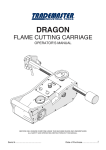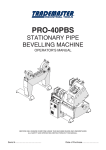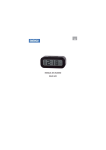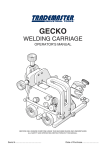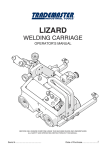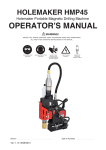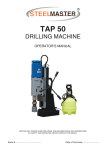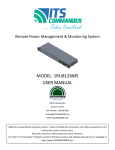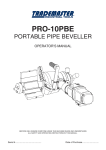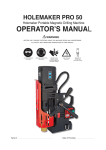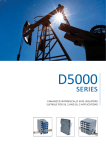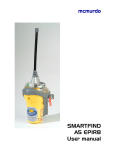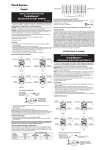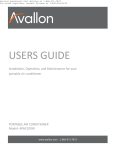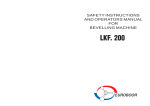Download ABM28 User Manual.indd - Industrial Tool and Machinery Sales
Transcript
ABM-28 AUTO FEED BEVELLING MACHINE FOR PLATE EDGES OPERATOR’S MANUAL BEFORE USE, ENSURE EVERYONE USING THIS MACHINE READS AND UNDERSTANDS ALL SAFETY AND OPERATING INSTRUCTIONS IN THIS MANUAL . Serial #............................................ Date of Purchase............................ TRADEMASTER ABM-28 AUTO FEED BEVELLING MACHINE IMPORTED & DISTRIBUTED BY INDUSTRIAL TOOL & MACHINERY SALES INDUSTRIAL TOOL T F E W 18 BUSINESS ST YATALA QLD 4207 AUSTRALIA 07 3287 1114 07 3287 1115 [email protected] www.industrialtool.com.au WARRANTY TERMS In addition to any warranties or conditions implied by applicable Statute or Regulations, Industrial Tool & Machinery Sales warrants all of it’s products against defective workmanship and faulty materials for a period of twelve (12) months from the date of purchase, unless otherwise stated. At our option we will repair or replace, free of charge, any item on the condition that: • The complete machine or tool is returned, freight prepaid to ITM or one of it’s authorised service agents as directed by ITM, and is found to have a material or constructional defect. • The machine or tool has not been subject to misuse, neglect or damage by accident. • The fault is not a result of normal “wear and tear”. • Written permission has been received from ITM prior to commencement of repair. • Repairs, tampering or modification carried out by unauthorised personnel will void all warranty. • Consumable items such as cutting tools, pilot pins, saw blades, grinding wheels etc. are NOT covered by warranty. Our goods come with guarantees which cannot be excluded under the Australian Consumer Law. You are entitled to replacement or refund for a major failure and to compensation for other reasonably foreseeable loss or damage. You are also entitled to have the goods repaired or replaced if the goods fail to be of acceptable quality and the failure does not amount to a major failure. 2 TRADEMASTER ABM-28 AUTO FEED BEVELLING MACHINE TABLE OF CONTENTS 1. 1.1. 1.2. Safety Instructions Application Safety Requirements -4-4-4- 2. 2.1. 2.2. 2.3. Technical Data Design Equipment Included Optional Equipment -6-7-9-9- 3. 3.1. 3.2. 3.3. 3.4. 3.5. 3.6. Start Up & Operation Preparation Setting Bevel Parameters Usage Replacing Cutting Inserts Replacing Milling Head Replacing Milling Unit Support - 10 - 10 - 12 - 13 - 14 - 15 - 16 - 4. Wiring Diagram - 17 - 5. Spare & Wearing Parts - 18 - 3 SAFETY INSTRUCTIONS READ OPERATOR’S MANUAL BEFORE YOU START TO WORK WITH THE MACHINE. 1. Safety Instructions The ABM-28 auto feed bevelling machine should be used only to applications stated in the manual. Using in other applications may lead to personal injury and machine damage. 1.1. Application The ABM-28 bevelling machine is designed for milling edges of plates with the thickness up to 35 mm (1.38’’). The bevelling angle can be set continuously between 60° and –60°, including facing at 0°. The feed is performed automatically after starting by the operator. Using optional equipment enables you to establish J-bevels or to bevel 35-70 mm (1.38–2.76’’) thick plates at the continuously set angle between 0° and 60° or between 0° and –60°. 1.2. Safety Requirements Using beveller is not allowed if: 1. The operator has not read the Operator’s Manual or has not completed proper occupational safety and health training. 2. Machine is to be used in applications not stated in Operator’s Manual 3. Machine is not complete or parts used for repair are not genuine. 4. Power supply specifications do not conform to those stated on rating plate. 5. Operator has not checked condition of machine, including power cord, control panel components and milling tools. 6. Machined pipe is not properly secured from falling or rolling. 7. Bystanders are present in immediate vicinity of machine. Detailed safety rules: 8. 9. 10. 11. 12. 13. 14. 15. 16. 17. 18. 4 Before starting, read this Operator’s Manual and complete proper occupational safety and health training. Machine must be used only in applications stated in Operator’s Manual. Machine must be complete and all parts must be genuine and fully operational. Power supply specifications must conform to those stated on rating plate. Power supply socket must be equipped with grounding pin. Never carry machine by cord or yank it to disconnect plug from socket. It may cause power cord to break and result in electric shock. Untrained bystanders must not be present near machine. Before starting, check condition of machine and electrical installation, including power cord, plug, control components, and milling tools. Check presence of protective bolts at both guide ends. Keep machine dry. Exposing it to rain, snow, or frost is prohibited. Keep work area clean and well lit. SAFETY INSTRUCTIONS 19. 20. 21. 22. 23. 24. 25. 26. 27. 28. 29. 30. 31. 32. Never use machine in vicinity of flammable fluids or gases, or in explosive environments. Never use blunt or damaged tools. Use only tools recommended by manufacturer and specified in Operator’s Manual. Mount cutting inserts and milling head securely. Remove adjusting keys and wrenches from work area before connecting plug to power socket. If cutting edge of insert is worn out, rotate insert in socket by 90° or, if all edges are worn out, replace with new insert specified in Operator’s Manual. Before every use, inspect machine to ensure it is not damaged. Check whether any part is cracked or improperly fitted. Make sure to maintain proper conditions that may affect machine operation. Always use safety goggles, hearing protection, protective shoes, and protective clothing during operation. Do not wear loose clothing. Do not touch moving parts or metal chips formed during milling. Prevent objects from being caught in moving parts. After every use, remove metal chips from machine, particularly from milling head. Never remove metal chips with bare hands. Carry chips container using handles. Maintain machine and tools with care. Cover steel parts with thin grease layer to protect them against rust when not in use for a longer period. Perform all maintenance work only with power cord unplugged from power socket. Perform all repairs only in service centre appointed by seller. If machine falls on hard surface, from height, is wet, or has other damage that could affect technical state of machine, stop operation and immediately send machine to service centre for inspection. WARNING! SAFETY RULES MUST BE CLOSELY OBSERVED. 5 TECHNICAL DATA 2. Technical Data 1211 mm (47.7’’) 619 mm (24.4’’) 532 mm (20.9’’) Voltage Power Rotational speed (without load) Protection level Protection class Bevel angle Maximum bevel width Minimum plate thickness Weight 6 ~ 220–240 V, 50–60 Hz 1600 W 2780 min-1 IP 20 class I 60 to –60° (ß, Figure 1) 35 mm (b, Figure 1, Table 1) 10 mm 78.5 kg (173 lbs) TECHNICAL DATA Figure 1. Bevel dimensions b 0° 35 mm 30° 30 mm 45° 28 mm 60° 30 mm Table 1. Maximum bevel width depending on the angle 2.1. Design The ABM-28 bevelling machine consists of a milling unit, milling unit support, guide, carriage for moving the milling unit along the guide, two movable clamps for mounting a plate, and three set blocks for positioning and mounting the guide to the plate. Detailed design is shown in Figure 2. 7 TECHNICAL DATA protecƟve bolt travel direcƟon switch emergency switch guide segment speed adjusƟng knob supply socket for milling unit motor ON switch overload lamp motor OFF switch carrying handle power ON/OFF switch A protecƟve bolt chips clamping lever chips container bevel depth indicator bevel angle pitch container handle milling head bevel depth it h adjusƟng bolt clamping rod A bevel depth lock lever bevel angle lock lever container bracket spindle lock buƩon bevel angle lock lever bevel depth adjusƟng lever Figure 2. Machine design 8 TECHNICAL DATA 2.2. Equipment Included The ABM-28 is supplied in a wooden box with the complete standard equipment. The included equipment consists of: • • • • • • • • • • • • • • • • • • wooden box carriage on a guide additional guide segment clamp set block milling unit support for bevelling at –60° to 60° milling unit chips container tools container 4 mm Allen key 5 mm Allen key 6 mm Allen key 8 mm Allen key 13/17 mm flat key screwdriver for securing cutting inserts nut, spring washer, round washer for mounting milling unit support Terebor oil for steel Operator’s Manual – 1 unit – 1 unit – 1 unit – 2 units – 3 units – 1 unit – 1 unit – 1 unit – 1 unit – 1 unit – 1 unit – 1 unit – 1 unit – 1 unit – 1 unit – 2 units – 1 unit – 1 unit 2.3. Optional Equipment You can order the following optional equipment: WAP-B010 • Replacement cutting tips for hardened steels (10 required) WAP-B020 • Replacement standard cutting tips (10 required) WAP-B28/6130 • Lever Clamp for plate up to 35mm thick WAP-B28/6140 • Lever Clamp for plate up to 70mm thick WAP-B28/6150 • Positioner unit for plate up to 35mm thick WAP-B28/6160 • Positioner unit for plate up to 70mm thick WAP-B28/6170 • Rail segment 1200mm long WAP-B28/6180 • Milling unit support for bevelling 35-70mm 0 ° to 60° WAP-B28/6190 • Milling unit support for bevelling 35-70mm 0 ° to -60° 9 START UP & OPERATION 3. Start Up & Operation WARNING! Read safety precautions before starting. 3.1. Preparation The carriage set on the guide in the utmost left position must be placed on a plate between two movable clamps in the manner shown in Figure 3a. If needed, extend the guide length by connecting additional guide segments and tighten the set screws using a 4 mm Allen key (Figure 3b). Then, mount the protective bolts 1 and 2 at both ends of the guide, and position the guide using set blocks in a way to align the set blocks with the respective surfaces of the guide and plate. Mount the set blocks using levers (3, 4, 5) and tighten the clamp screws by rotating the clamping rods (6, 7). To adjust the pressing force of set blocks depending on plate thickness, use adjusting screws which can be located in one of the three holes. a) b) 1 set screw 9 2 6 10 3 8 4 5 7 Figure.3. Placing machine on plate (a); mounting additional guide segments (b) 10 STARTUP & OPERATION If the plate is to be machined at a negative angle (from the bottom), loosen the two milling unit support screws using the 4 mm Allen key, and set the indicator to the value of the plate thickness (8). Position the milling unit support on the screws (9), place the washers under the nuts (10) in the order shown in Figure 3, and tighten the nuts using 13 mm flat key. Connect the milling unit with the bevel depth adjusting lever in utmost left position as in Figure 4 to the support (1), rotate the lever maximally counterclockwise (2), and lock the bevel depth lock lever (3). If the plate is to be machined at the positive angle (from the top), attach the chips container to the brackets (4). 1 3 2 4 Figure.4. Method of mounting milling unit 11 START UP & OPERATION 3.2. Setting Bevel Parameters Loosen the lever 1 (Figure 5) and rotate the lever 2 to set the proper milling head penetration in working material on the pitch 3 (one graduation equals 1 mm, 0.04’’), and afterward lock the position using lever 1. 6 1 5 4 3 2 Figure.5. View of milling unit Then, loosen the levers 4 and 5, and rotate the milling unit in a way to set the bevel angle on the pitch 6, and afterward lock the levers 4 and 5. It is recommended to start bevelling with the milling head maximally retracted, especially when milling at the angle of 0°. 12 START UP & OPERATION 3.3. Usage Plug the milling unit power cord into the socket 1 (Figure 6), and the plug 2 into power socket. Then, set the power switch 3 to position “1” and use the knob 4 to change the carriage travel speed to minimum. Choose right travel direction using the switch 5 and start the motor with the button 6. 2 1 9 5 4 3 6 7 8 Figure.6. View of control panel Once the travel is started, set a speed that will ensure sufficient milling performance, while preventing motor overload and excessive wear of the cutting inserts. Good effects are achieved with a speed at which the overload lamp 7 will not flash. The plate must be at every time pressed by two set blocks positioned as close to the current carriage position as possible. When the carriage gets close to the set block, relocate the block to the other side of the carriage. It is recommended to establish bevels in several passes and to not exceed 4 mm (0.16’’) of the milling head penetration (Figure 1) in a single pass. When the carriage reaches the plate end, toggle the switch 5 to the opposite travel direction or first stop the carriage with the button 8 and then readjust the bevel depth or angle. Once the bevelling is finished, perform the finishing machining by travelling the carriage with minimal milling head penetration and without using the set blocks. In an emergency, use the emergency switch 9 to shut down the power. In such case, to restart the operation, remove the cause of the shutdown, unlock the emergency switch, and start the machine using the button 6. 13 START UP & OPERATION If the speed is too high for the set bevel width and depth, the machine will cyclically stop and start. In such case, decrease the travel speed or milling head penetration in the workpiece. If the machine becomes overloaded, e.g. when the bevel width is too large for the material being machined, when the cutting inserts are blunt, or when the carriage travel speed and bevel depth are too high, the spindle will automatically stop. In such case, press and hold the button 6, which will travel the carriage in the opposite direction and will enable the operator to retract the milling head from the workpiece. Then, release the button 6, press the button 8, and after removing the cause of the shutdown, restart the motor using the button 6. If the carriage stops due to reaching one of the protective bolts, toggle to the opposite travel direction using the switch 5 before restarting. Operating with the maximum permitted load (flashing of the overload lamp) is allowed, but the motor temperature must not exceed 85°C (185°F). This type of motor can work under high temperatures, but long-lasting overheating can permanently damage its windings. Therefore, after longer working under full load (maximum 1 hour), stop the motor to cool it down for 10–15 minutes. Do not cool down the motor by running it without load, because it will become heated even faster than when working with load. Once the work is finished, turn off the motor using the button 8, toggle the power switch to position “0”, and unplug the power cord from power socket. 3.4. Replacing Cutting Inserts 3 1 2 Figure.7. Method of dismounting milling unit 14 START UP & OPERATION Unscrew the set screw in the manner shown in Figure 8, remove the insert, and clean the socket. Next, place the rotated insert again or replace with a new one if all four edges are worn out, and secure with the set screw. Figure.8. Method of replacing cutting inserts 3.5. Replacing Milling Head Unplug the power cord from power socket and remove the plug from the supply socket for milling unit. Dismount the milling unit in the manner shown in Figure 7, press and hold the spindle lock button, and use 5 mm Allen key to loosen the bolt (Figure 9). Then, release the lock button and remove the head. Mount in the reverse order. mounƟng bolt spindle lock buƩon Figure.9. Method of dismounting milling head 15 START UP & OPERATION 3.6. Replacing Milling Unit Support Unplug the power cord from power socket, remove the plug from the supply socket for milling unit, and dismount the milling unit as shown in Figure 7. Then, unscrew the nuts using 13 mm flat key (1, Figure 10), and take out the mounted support (2). Before you install the support for machining plates at the negative angle (from the bottom), loosen its two screws using 4 mm Allen key and set the indicator to the value of the plate thickness (3). Position the milling unit support on the screws (4), place the washers under the nuts (1) in the order shown in Figure 10, and tighten the nuts afterward. Mount the milling unit in the manner shown in Figure 4. 2 1 3 4 Figure.10. Method of replacing milling head support 16 WIRING DIAGRAM 4. Wiring Diagram 17 SPARE & WEARING PARTS 5. Spare & Wearing Parts WAP-B010 WAP-B020 WAP-B28/6130 WAP-B28/6140 WAP-B28/6150 WAP-B28/6160 WAP-B28/6170 WAP-B28/6180 WAP-B28/6190 18 • Replacement cutting tips for hardened steels (10 required) • Replacement standard cutting tips (10 required) • Lever Clamp for plate up to 35mm thick • Lever Clamp for plate up to 70mm thick • Positioner unit for plate up to 35mm thick • Positioner unit for plate up to 70mm thick • Rail segment 1200mm long • Milling unit support for bevelling 35-70mm 0 ° to 60° • Milling unit support for bevelling 35-70mm 0 ° to -60°


















